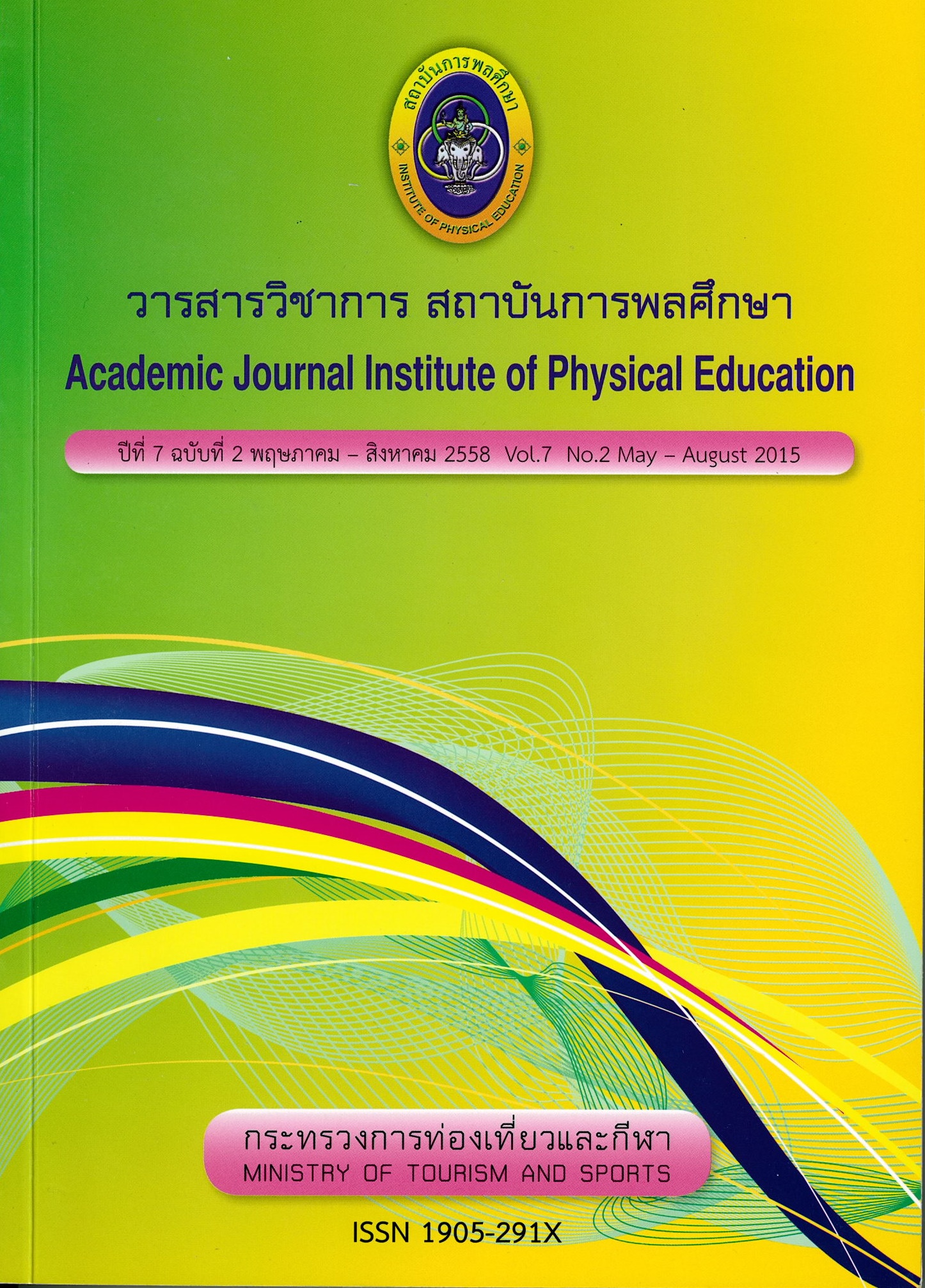The Relationship of Maximal Oxygen Consumption Measures by Astrand-R vhming test and Step Test at Different Step Box Heights
Main Article Content
Abstract
This research aimed to study the relationship of maximal oxygen consumption measured by Astrand-Ryhming Test and Step Test with height of step box at 13.25 inches, 14.25 inches, 15.25 inches and 16.25 inches. Subjects were Burapha University undergraduate students who registered for Exercise for Health course. Stratified sampling was employed to obtain thirty male subject groups. The research was divided into five phases in a period of 48 hours apart. In Phase 1, maximum oxygen consumption was measured by Astrand-Ryhming Test and Phase 2 to Phase 5 maximum oxygen consumption was measured by Step-Test in different step box heights. Pearson's Product-Moment Correlation coefficient method was used to see it any relationship existed. Results showed relationship of maximal oxygen consumption existed at high level measured by step box height at 16.25 inches and Astrand-Ryhming Test (r =.764, p<.05) while the step box height at 15.25 inches and 14.25 inches correlated with Astrand-Ryhming Test at moderate (r = .565, p<.05) and low (r =.369, p < .05) levels respectively.
In conclusion, the test of maximal oxygen consumption with step height of 16.25 inches in male showed highest relationship with maximal oxygen consumption obtained by Astrand-Ryhming Test.
Article Details

This work is licensed under a Creative Commons Attribution-NonCommercial-NoDerivatives 4.0 International License.
The published article is a copyright of the Academic Journal of Thailand National Sports University. The passage appeared in each article in this academic journal is a perspective of each author which is not related to the journal. Each author is required to be responsible for all components of his/her own article. If there are any mistakes, each author must be responsible for those mistakes on his/her own.
References
ชูศักดิ์ เวชแพศย์ และ กันยา ปาละวิวัธน์. (2536), สรีรวิทยาของการออกกําลังกาย, พิมพ์ครั้งที่ 4. กรุงเทพฯ: ไทยวัฒนาพานิช.
ณัฐพล ไตรเพิ่ม. (2546). การออกกําลังกายแบบแอโรบิคในปริมาณงานที่แตกต่างกันที่มีผลต่อสมรรถภาพการใช้ออกซิเจน ความจุปอด และเปอร์เซ็นต์ไขมันในร่างกาย วิทยานิพนธ์ ปริญญาศึกษาศาสตรมหาบัณฑิต สาขาวิชาพลศึกษา บัณฑิตวิทยาลัย มหาวิทยาลัยขอนแก่น.
ประทุม ม่วงมี. (2527), รากฐานทางสรีรวิทยาของการออกกําลังกายและการพลศึกษา. กรุงเทพมหานคร: บูรพาสาสน์.
ภัทรพร สิทธิเลิศพิศาล (2554). เอกสารประกอบการสอนรายวิชา 518724 การวัดความสามารถในการใช้ออกซิเจนคณะเทคนิคการแพทย์ ภาควิชากายภาพบําบัด มหาวิทยาลัยเชียงใหม่,
ราตรี เรืองไทย. (2545). เอกสารประกอบการสอนรายวิชา 183512 การทดสอบสมรรถภาพทางกาย และการฝึกทางกาย เรื่อง Cardiorespiratory Fitness Test. ภาควิชาวิทยาศาสตร์การกีฬา คณะศึกษาศาสตร์ มหาวิทยาลัยเกษตรศาสตร์, กรุงเทพฯ.
American College of Sports Medicine. (2000). ACSM's guidelines for exercise testing and prescription. Philadelphia, PA: Lippincott,
Williams & Wilkins. ACSM's Guidelines for Exercise Testing and Prescription, 8th ed. Baltimore: Lippincott.
Williams and Wilkins, 2010. Åstrand, PO and Ryhming, I (1954). A nomogram for calculation of aerobic capacity (physical fitness) from pulse rate during submaximal work. J. Appl Physiol., 7: 218-221.
Chatterjee.S, Chatterjee. P, Bandyopadhyay.A. Validity of Queen's College step test for estimation of maximum oxygen uptake in female students. Indian Journal of Medical Research 2005; 121:32-35.
Chatterjee S, Chatterjee P, Mukherjee PS, Bandyopadhyay A, 2004. Validity of Queen's College step test for use with young Indian men. Br J Sports Med; 38: 289-291.
Chin-Mou Liu. (2007). Estimation of vo max: A comparative analysis of post-exercise heart rate and physical fitness index from 3-minute step test National Hsinchu University of Education, Hsinchu,
TAIWAN Getchell and Wayne (1982)Being Fit: A Personal Guide (Wiley Self-Teaching Guides), 1 edition Wiley Publisher.
Katch, V. L., McArdle, W. D. &Katch, F. I. (2011) Essentials of Exercise Physiology (4th ed.). Philadelphia: Wolters Kluwer/Lippincott Williams & Wilkins.
William J. Kraemer et al., (2012) Exercise Physiology Integrating Theory and Application (1st ed.) Philadelphia: Wolters Kluwer/ Lippincott Williams & Wilkins.


